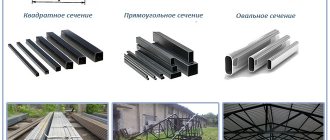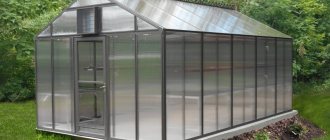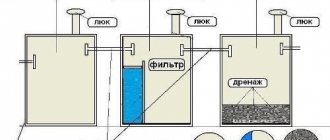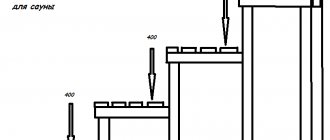A fair part of Russia's territory is located in the zone of risky agriculture, therefore, to obtain crops on their plots, summer residents grow vegetables in greenhouses and hotbeds. The disadvantage of this method is that in a closed glassed room under the influence of sunlight, the temperature and humidity are excessively high, which leads to plant diseases and reduced yield.
Do you think ventilation is needed for a greenhouse?
Necessarily
0%
Not necessarily, everything grows anyway
0%
Voted: 0
It is also impossible to leave the greenhouse open, because... Night temperature drops negatively affect the life of cultivated plants. Those who permanently live on the site open and close the greenhouse doors twice a day. Summer residents visiting country estates on weekends can build automatic greenhouse ventilation with their own hands.
Why do you need to ventilate a greenhouse?
In greenhouses, it is necessary to maintain a temperature regime that is favorable for the planted plants. The greenhouse effect creates suitable conditions for the growth and development of heat-loving seedlings, but if there is no circulation of fresh air, the plants in the greenhouse begin to get sick. Without ventilation, the seedlings' photosynthesis process is disrupted and they do not receive enough vital elements. The air temperature rises and the plant dies. Therefore, ventilation of greenhouses is necessary and should be carried out regularly.
Gardeners often face the problem of opening windows or doors in a timely manner. There are situations when a person simply forgot that the greenhouse is closed or open. When he remembers this, the plants have already suffered and require immediate resuscitation. To prevent such cases, a thermal drive was invented that opens the windows or doors of the greenhouse automatically.
Design features
So, what is ventilation of greenhouses, what principles does this process follow? Essentially, these are several vents installed in the greenhouse structure, which automatically open and close.
And here the question arises about the number of vents to be installed. That is, how many of them are needed so as not to change the microclimate. To do this, you will have to calculate the internal volume of the greenhouse, and based on this parameter, select the number of openings. It is not recommended to do this on your own; you can make a mistake that will negatively affect the future condition of the plants. Leave it to the experts.
Next, you need to decide where the windows will be located. There are two options here:
- End location. To do this, doors and vents are installed on the end walls of the greenhouse. By opening them, you can quickly reduce the humidity inside the room. This is a good ventilation option, which also has a significant disadvantage - the formation of drafts. And this often leads to diseases of green spaces.
End arrangement of vents Source freeimport.ru
- Lateral location. Better than the end one in terms of proper air circulation. Namely: from bottom to top. Therefore, it is recommended to place the windows as high as possible. At the same time, cold air, sinking to the ground, has time to heat up. That is, it does not have a negative effect on plants.
Lateral arrangement of vents Source static.wixstatic.com
See also: Catalog of popular garden house projects
How does a thermal drive work?
The operation of the device depends on the air temperature. On a clear day, when the sun heats the greenhouse, the liquid in the thermal drive parts heats up, parts of the device expand and push the door or window. It opens and air flows to the plants. Closer to sunset, the air temperature outside and, accordingly, in the greenhouse decreases. The thermal drive cools down and contracts, the vents close completely.
Comment! To ensure that the thermal drive located under the ceiling does not heat up from the sun's rays, but only from the air temperature, it is recommended to shade it.
Software part
Everything is clear with the equipment. It remains to deal with the programs that manage it and control the state of the entire system. Since the complex contains two highly intelligent devices - ESS8266 and Arduino itself. Accordingly, both need their own programs. Placing them in the device memory, in both cases, is done through the Arduino IDE.
Monitoring
A sketch that needs to be uploaded to the ESP8266 LoLin NodeMCU to ensure its communication with the Arduino and WiFi router.
Control
And finally, a large sketch of controlling the greenhouse itself, which is uploaded to Arduino.
Design Notes
It is advisable to replace the DN11 sensor with a DN22, which, although more expensive, is more accurate and functions without the problems inherent in its younger namesake. To power the control circuits, you can use a computer power supply, preferably an AT form factor.
We recommend reading: follow the link if you want to learn how to connect a soil moisture sensor to Arduino.
Types of thermal drives for greenhouses
Thermal actuators are divided into types, the principle of operation of which differs from each other. Each of them is designed for different types of vents and provides different ventilation methods. If the sash opens upward, some thermal actuators may be unusable. Each type of device has its own advantages and disadvantages that you need to know about.
Electrical
It is a ventilation system with blade elements that are activated using temperature sensors.
| Advantages | Flaws |
| Capable of providing complete ventilation in greenhouses of any size | Does not work in case of power outage. |
| The temperature sensor works without errors. | Produces a low but audible noise. |
| Suitable for greenhouses of any design (polycarbonate, film, glass.) |
The temperature at which the vents open and close can be adjusted manually. Standard mode: opening from + 23 °C, closing from + 17 °C.
Another option for an electric drive for greenhouses is a mechanism similar to a device operating on a hydraulic principle. The pin is driven mechanically, following a signal from a temperature sensor. You can make such a thermal drive yourself.
Pneumatic
The thermal actuator consists of a cylinder with compressed air and a rod, which, when the air is heated, moves out of the structure and lifts or opens the doors of the greenhouse. The rod drops inward when the temperature begins to drop.
| Advantages | Flaws |
| Works without power. | Gradual closure. If the air temperature drops sharply, the window will not close immediately. |
| Easy to install. | The device is sensitive to the temperature only of the place where it is attached. |
| The force of the retractable rod is 18 kg, which guarantees the functionality of the device for any type of vents. |
Comment! If the window is located on the wall and opens to the side, then a spring or a closer is needed to close it.
Hydraulic
Such devices work similarly to the previous ones, the only difference is that instead of compressed air, there is liquid in the cylinder. Basically it is oil, the particles of which expand when heated and push out the rod. The vent closes slowly when the temperature drops. Ventilation is carried out by a smooth change of air, thanks to the inertia of the thermal drive.
Bimetallic
The thermal actuator consists of metal plates that have the ability to expand when exposed to warm air. When the air in the greenhouse heats up, one of the plates bends and pushes the window.
| Advantages | Flaws |
| A budget option. | Low power. The device is capable of opening small windows, but will not be able to move the door. |
| Easy installation. |
Gardeners using bimetal as a thermal drive for greenhouses noted that the plates heat up slowly. Therefore, this type of device is not popular.
Lighting
In a greenhouse, lighting is necessary for growing light-loving categories of plants. The lamps are connected using a second relay located on the Relay Shield. The degree of illumination will allow you to determine the photoresistor, which works in conjunction with a conventional resistor. You can purchase a Light Sensor module, which contains all the necessary resistor options.
Homemade thermal drive for a greenhouse
Ready-made devices for automatically opening greenhouses are expensive; in order to save money, you can make a thermal drive yourself. First, you need to decide how long the service life of the homemade device is expected to last. There are options that will last only one season, but you can make a thermal drive that will last several years. For those who are familiar with electricity, you can make an electric drive for the greenhouse door, but there are simpler options.
From an inflatable ball and cylinders
This version of a homemade thermal drive can last 1-2 seasons. To make it you will need:
- wooden box;
- 2 cylinders;
- rubber hose;
- board;
- the ball or camera from under it.
The cylinders are fastened together using tape or wire. A rubber hose is attached to them. The other end of the hose is attached to the inflatable valve of the ball. The ball is placed in a box so that when it expands it pushes out the wooden lid. The box is placed under the window, and a board is placed on the lid so that when it is moved, the board opens the window. The cylinders are suspended from the ceiling.
As the temperature rises, the cylinders heat up and supply warm air through the hose into the ball. He inflates and pushes off the lid of the box. The board fixed at the top puts pressure on the window frame, opening it. When the air temperature decreases, the process occurs in the opposite direction.
Comment! The hose must be of such length that air can pass through unhindered. You can't leave any extra length.
From a plastic bottle
The cheapest and fastest way to build a thermal drive for a greenhouse with your own hands. This option will only last 1 season.
Materials:
- 2 bottles, one of which is 5 l and the other is 1 l;
- dark tint film:
- board;
- pipes 2 pcs.;
- thin tube over 100 cm long.
The bottles are washed and dried. A large container is wrapped in dark film and a hole is drilled in it. Insert the pipe and connect it to one end of the tube. The joint is made airtight by coating the joint with a special paste. A 5-liter bottle is fixed under the ceiling. The second end of the tube is connected to the neck of a liter bottle, and a board is attached on top.
A liter bottle crumpled under the board under the influence of air from the top 5-liter container will straighten and lift the board. That, in turn, will have an impact on the window frame, lifting it.
Comment! This design is not suitable for opening massive, heavy doors.
From an office chair cylinder
Office chairs have a mechanism that adjusts the height of the seat, it is called a gas lift. This part is suitable for constructing a thermal drive.
Additional tools:
- machine oil;
- a piece of metal pipe of suitable diameter;
- welding machine;
- Bulgarian saw;
- vice.
The end of the plastic rod is clamped in a vice and pulled out until the pin on the valve becomes visible. Bleed air from the main cylinder. Its axis is fixed in a vice and pressed from above. The upper part of the cylinder is carefully trimmed with a grinder. There is a risk of damaging the seal and the surface of the part itself.
The rod is carefully removed from the sleeve, monitoring the condition of the seal. It must not be damaged. To prevent the rod from falling back into the cylinder, a nut is screwed onto it. Then the aluminum piston is inserted and welded. The final step is to screw the nut onto the thread, and then fix the rod on the window frame. Oil is poured into the ventilator and it is ready for use. The operating principle will be hydraulic.
From an automobile hydraulic cylinder
This thermal drive option will last for several years. To make such a device for ventilating greenhouses, it will take about 1 hour.
First, the gas is squeezed out of the shock absorber, and then a small hole is drilled and threaded. The brake hose is fixed in the hole. The receiver for the thermal drive is made independently or ordered from turners. Oil is poured into the shock absorber, and the rod is completely immersed inside. The device is ready, all that remains is to make sure that it is completely sealed and make sure that the oil does not drip. The structure is attached with a rod to the window, and the other end is fixed to the support.
Comment! The device will work better if it is placed at the top of the greenhouse.
From a car shock absorber
What is required to create such a thermal drive:
- shock absorber piston or spring;
- taps 2 pcs.;
- cylindrical container for oil (metal pipe);
- machine oil.
Taps are welded at both ends of the pipe. One of them will serve as a pressure regulator, and the other as a hole for filling with oil. The bottom of the spring is cut off using a grinder. Then it is welded to the pipe. The final step is to check the device for leaks.
Comment! This type of thermal drive is suitable for large greenhouses and heavy window frames.
Reliable automation with pneumatic drive
You can equip automatic ventilation of greenhouses with your own hands. The simplest option is a pneumatic drive from a hydraulic cylinder.
List of required materials
For installation you will need a couple of days, tools and several components:
- a piece of plastic pipe in the form of a cylinder with a length of 300-350 mm and a diameter of 200 mm;
- a piece of plexiglass with a thickness of 5 mm;
- wooden stick for making a rod;
- soccer ball camera;
- thin hose 1.5 - 2 m long.
Attention! A plastic pipe can be replaced by any cylinder made from scrap materials. For example, from polycarbonate left over after installing a greenhouse or greenhouse.
Pneumatic greenhouse ventilation
Preparing to install the cylinder
- Take a pipe and make two sealed plexiglass plugs for it. The top one will serve as a guide for the rod.
- Make a piston from plexiglass. It should be 1-2 mm smaller than the internal diameter of the cylinder.
- The rod is made of wood or a piece of plastic pipe (size 32). If you choose the wooden option, then a stick 500 mm long and 40 mm in diameter needs to be sanded and coated with an antiseptic.
- Drill holes in both plugs. On the bottom – with a diameter of 10 mm. On the top - such that the rod fits in it.
Installing a thermal drive on a greenhouse door or window
What needs to be done to ensure that the thermal drive copes with its task:
- Make sure that the door or window opens without much effort.
- Considering that the rod of the device will extend by 10-12 on its own, you need to mark its location on the doorway or window frame and screw the bracket.
- The spring is fixed on the frame. This will prevent the device and frame from moving to the side.
- The final step is to attach the thermal drive to the ceiling.
Comment! The best place to install a thermal drive is the ceiling of the greenhouse. According to the laws of physics, warm air rises and cold air remains below. This means that the device will operate on time and the plants will not suffer from overheating.
Pneumatic cylinder assembly
- Glue the bottom plug to the cylinder.
- Place the ball chamber inside, tightly connected to the hose.
- Pass the hose through the plug. Secure the rod in the center of the piston. Insert the piston into the cylinder so that it presses the ball.
- Pass the rod through the top plug and seal it tightly to the cylinder.
Advice . If you secure the guide with tape, you can remove it and service the device in case of a malfunction.
The pneumatic cylinder, created from a hydraulic cylinder, is completely ready. When air flows through the hose, it will inflate the ball, which will lift and push the piston and rod.
Stages of work on installing the receiver
The assembled part is only half of the automatic ventilator. For it to work properly, you need to connect the hydraulic cylinder to a container with air, that is, to the receiver. The larger the receiver, the higher the air pressure inflating the ball.
Receiver from a canister
A large paint can or canister with a capacity of 20 liters is suitable as a container for air. The main thing is that they are hermetically sealed.
- At the bottom of a tightly closed canister, you need to install two pipes.
- Connect one of them tightly to the hose entering the hydraulic cylinder.
- On the second, put a piece of hose 100-150 mm long. Pump air into it and turn it off when the rod extends a little.
The receiver is ready! When the air pressure increases, it flows through the pipe into the hydraulic cylinder, and the rod opens the transom, providing automatic ventilation of the greenhouse.
How to properly install a finished mechanism
The automatic device should be connected to one window that opens along a horizontal axis. It is important to install the receiver so that it is not exposed to sunlight. It is best to hang it under the roof of the greenhouse, covering it with foil or other protective screen.
The pneumatic drive connected to the receiver should be installed next to the window. A rod attached to the window will raise the frame as soon as the greenhouse gets hot. And it will go down when it gets cold.
The invention should be calibrated by adjusting the pressure inside the system using a free hose. Calibration allows you to achieve the opening and closing of the window at a certain temperature.
Advantage of the device: the unit can be constructed independently from scrap materials.
Minus: the hydraulic cylinder is designed for light horizontal transoms.
Which thermal drive is best for a greenhouse?
If plants are planted in the greenhouse that react sharply to temperature changes, then the best option would be to purchase an electric thermal drive. Sensors adjust the height of the rod that opens the windows in accordance with the warming of the air. The pin lowers and rises smoothly, but in case of sudden cold weather the window will close quickly.
Hydraulic and pneumatic devices are suitable for ventilating greenhouses with tomatoes. Tomato bushes do not like drafts. For normal growth of these plants, smooth air currents are needed. Hydraulic and pneumatic thermal drives operate smoothly. The pin extends as the oil or air inside the device warms up, so that the ventilation is regulated, creating optimal conditions for the seedlings.
Do-it-yourself thermal actuators from car parts or gas lift from an office chair are suitable for large greenhouses. The pins extend with a force of more than 20 kg.
Comment! If the greenhouse is small in size and the windows and doors are light, then there is no need to spend money on expensive devices. You can install a bimetal thermal drive.
Construction portal No. 1
12/18/2018 admin Comments No comments
Creating a comfortable atmosphere in the greenhouse provides its owner with an excellent result in the form of a healthy and abundant harvest. An important factor in this process is ventilation of the greenhouse. By setting it up correctly, the process can be reduced to maximum automation. However, you should not neglect the natural methods of ventilating this room.
Rating of the best manufacturers
For those who want to save time, purchased options are suitable. Experienced gardeners prefer 5 well-known brands with good characteristics that make thermal actuators for greenhouses.
Dusya San
The device operates on a hydraulic principle, at a temperature not exceeding 50 °C. The operation of the thermal drive does not depend on power. The maximum load that the pin can lift is 7.5 kg.
“Dusya” can be installed in greenhouses of any type. The device is capable of lifting vertical and horizontal windows. When the temperature inside the greenhouse rises to 29 °C, the thermal drive opens the window to the limit.
Sesame-M-2015
The thermal drive operates on the basis of hydraulics. The main element is a black cylinder for quick heating. Machine oil is filled inside. This model runs smoothly. As the pin heats up, it slowly moves out, and when the air cools, it goes inward.
The device is suitable for use in large greenhouses. Capable of opening massive windows or door sashes. The maximum load weight on the movable rod is 12 kg. The kit includes special clamps in the form of hooks that help stop the movement of the pin. If necessary.
Thermal drive
A powerful domestic model that is capable of opening greenhouse doors weighing more than 20 kg. The maximum opening angle is 45°. The device does not look bulky and is easy to install. The work is carried out by hydraulics.
The manufacturer recommends not to overload the device with the heavy weight of the doors. Some elements may become deformed, and the operation of the thermal drive will become incorrect. In addition, it is necessary to monitor the oil level inside the main cylinder.
Open Planet
Using this device, the temperature in the greenhouse can be adjusted from + 14 to + 24 °C. It is believed that these are optimal conditions for the proper development of plants. The device operates on a pneumatic principle.
The manufacturer recommends removing the thermal drive for the winter. There is a possibility of damage to the main cylinder in frosts below - 20 ° C. Open Planet is made of stainless steel, so it is not subject to corrosion. The maximum load is 15 kg.
Comfort AERO100
This ventilation system is designed for areas where winds constantly blow. The mechanism is considered one of the most powerful. The maximum load on the pin is 100 kg. The kit includes reinforced brackets. The force of the spring closing the doors is 6 kg.
The device starts opening windows at 24 °C inside the greenhouse. When reaching 29 °C, the rod extends to its full length. Can be used for greenhouse windows or doors.
General information about control systems
The intelligence of modern equipment is provided by microcontrollers. These are small and resource-constrained full-format computers, often located on a single board or chip. Despite their small size, their power is quite sufficient to control various equipment. Such microcomputers obtain the information necessary to perform their functions through various specialized sensors. The general location of devices in a single network is ensured through additional modules attached to the microcontroller.
Carrying out their program, intelligent devices issue control pulses to executing circuits including motors, pumps, heaters or any other devices to control which the entire system is created.
The basis of many of these complexes are controllers of the Arduino, STM, Ti MSP430, Netduino, Teensy, Particle Photon, ESP8266 series or other common boards of this type in the world. In addition, some specialists create their own versions of micro-computers that control equipment based on outdated PCs or some 8-bit processors, for example, the Z80.
Recommendations for use and care
In order for the thermal drive to serve for a long time and work correctly, you must follow 3 rules:
- Once a month, inspect the device, lubricate it with oil if necessary, or replace the fluid in hydraulic mechanisms.
- Avoid rubbing against the greenhouse frame or wall.
- Remove the thermal drive during periods of low temperatures.
It is not advisable to attach the mechanism to dilapidated frame crossbars. Under heavy load, the automatic closer may jump out of the mount, or the beam may break.
Forced ventilation with fans
Forced ventilation of greenhouses is used for large areas. The principle of operation is several fans for air inflow and outflow, located at different ends of the greenhouse. The fans are controlled by a single-channel, two-channel and three-channel thermal drive (one channel for each mechanism).
Forced ventilation in a greenhouse
Automatic ventilation from computer parts
Usually they buy fans, but domestic DIYers have also found a way to build automatic ventilation in a greenhouse with their own hands.
Conditions: greenhouse 3x8 m. There are two vents on the end sides. Natural ventilation is not sufficient for a greenhouse of this size. The only thing left is to build a compulsory one.
The following materials are required for work:
- 2 old power supplies from the computer system unit;
- bimetallic thermal relay;
- car battery;
- wires.
Computer cooler
Photo of thermal drive for greenhouses
DIY ventilation
In the process of creating an automatic ventilator for greenhouses you will need:
- pneumatic drive;
- hydraulic cylinder;
- metal plates.
Hydraulics works according to the following principle: the liquid expands in response to heat, an increase in temperature leads to the displacement of liquid from one vessel to another (with a smaller volume). An enlarged small tank will open the transom. When the temperature drops again, the liquid is drawn back in and the transom closes.
The main advantage is maintaining absolute autonomy, durability and reliability. In addition, there is no need to connect electricity.
A significant disadvantage is that if there are sharp fluctuations in air temperature, the vents will not have time to close. Also, the system cannot be used with side transoms.
Pneumatic drive system
The work is based on energy obtained as a result of expansion of heated air masses. When manufacturing the device you need:
- piston with foam rod;
- connecting rubber hose;
- an old metal canister or other container for collecting air;
- a cylinder with a diameter of up to 20 cm with a soldered bottom;
- plastisol ball;
- pulley;
- bowstring cord;
- rocker.
The guide should be attached to the top of the cylindrical base. To ensure connection with the hose, a hole is drilled from below. Pneumatic ventilation works like this: the sun's rays warm the air in the canister. This causes the ball to inflate, causing the piston and rod to rise, the string to tighten, and the window to open. It closes after the liquid is compressed.
Bimetallic plates
To create the system, you will need bimetallic plates with different expansions. When the plate heats up, its dimensions increase, it bends, and the window opens. The reverse process will occur after cooling. To make it, you need to take strips of metal and planed boards (inch).
Two elements are fixed at the bottom of the greenhouse, and a block is inserted between the plate and the board and connected. The windows are fastened using hinges (bolts inserted into the tube).
The main advantage of such structures is that their production will be simple and cheap. But they do not have significant power, because they cannot open large windows.











